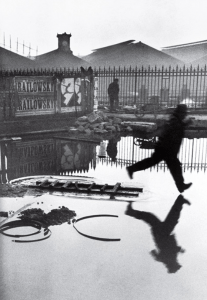Who is the practitioner (what is their name?) and when were they practising?
Henri Cartier-Bresson (22 August 1908 – 3 August 2004), a French photographer. He was inspired by a 1920 photograph of 3 naked boys by a Hungarian photojournalist, Martin Munkacsi. Therefore, he started to take up photography seriously from the early 1930s and retired from photography in the 1970s.

What is the title of the photo or video you have chosen to analyse (can you provide a link?)
‘Behind the Gare Saint-Lazare’. Click here for the photograph.

With the photo, you are examining when was it produced (date)?
It was produced in 1932 in Paris.
How was the photo or video authored?
Henri Cartier-Bresson used a Leica camera with 35mm film tape to create this black-and-white photo which he was also well-known for this. The photo was created at the very beginning of his photography career, yet he used this mobile camera to capture with a split-second shutter speed. The photo was taken behind a train station called Gare Saint-Lazare in Paris with a small construction area next to it and created a slightly flooded area. There was a man leaping on the puddle, who was just a second before his heel touched the water and ruined the perfect reflection. When Cartier-Bresson passed by and stuck his lens through the fence made up of wooden slats as he could (Harris and Zucker, 2012). Thus, it happened to have this photo created. Mentioned in his documentary (Analogish, 2017), that photographers have to be sensitive and aware of the surroundings, as the moment to press the shutter is just an instant of time.
The photograph’s particular exposure and the geometry were worth to investigate. He was well-known in the geometry of the photograph as he thought it creates a strong relationship with lines and shapes (Analogish 2017). So, in this image, there were elements matching the geometry forms, like the reflection from the man’s leap and the fence in the puddle, the rooftop with steady form, the arching forms on the foreground and some advertisements in the background. Therefore, the photograph snapshot a movement and yet with stability in it which create a balance. Also, it reflected the urban environment at the same time.
The image embodies Cartier-Bresson’s concept of the ‘decisive moment’, which is when the snapshot is immediate instantly captured and reflect the time, place and culture. The moment in the image was captured instantly within a fraction of second if not the man would step into the puddle and ruined the scene.
How was the photo or video published?
Unfortunately, there is little information offered on where the composition went after Cartier-Bresson’s creation. However, from MOMA (2020), it is given that the image was created in 1932 and printed in the 1950s with the medium of Gelatin silver print which was developed in the darkroom. The film had to wash with chemicals which are sensitive to lights, then it produces a film negative which is the black is produced to white, vice versa. This allows light could go through it and cast it into the light-sensitive paper to create the positive print. (Asto and Kayo, 2019).
Indeed, there were limitations to publish the image at that age. Tools and chemicals to produce the image were expensive, besides there were limited physical spaces such as printed magazines and newspaper. To be published by the news agencies, the image had to go through several examinations, this is absolutely distinct when compared to the accessibility in present days. Besides, photographs can’t be seen before print, which makes film photographing is so much excited.
Back to 1950s, when Cartier-Bresson printed the image as a preliminary based, he was deeply into the exposure and the geometry illustrated in the photo and the instant moment captured in the image (Harris and Zucker, 2012). As the moment was captured while the man was in the air before he landed on the puddle, the reflection was flawlessly structured, hence, the image was chosen to be one of the pieces in his ‘A Decisive Collection’. Additionally, he objected any post-editing or enhancement like cropping and lighting in his photo which interferes the originality of the photo. Therefore, it is believed that his photo could authentically reflect the actual environment or situation at that moment.
How was the photo or video distributed?
Though it is not available to specifically tell the distribution time and place of this piece of work. However, Cartier-Bresson had held various exhibitions throughout his career since 1933, so, it is believed that this art piece was once distributed in his exhibition. Indeed, the image was one of the photographs in his ‘A Decisive Collection’ which was familiar and popular that would be seen in different art galleries and exhibitions worldwide, including the exhibition ‘Henri Cartier-Bresson: A Decisive Collection’ held in Beetles+Huxley, London in 2015 and ‘Henri Cartier-Bresson: THE MAN, THE IMAGE & THE WORLD’, Queensland in 2011. Fans and photography lovers would surely visit the galleries and exhibitions for Cartier-Bresson’s artworks.
Of course, with the advanced of technology, the image is available online such as Pinterest, Google search and also can be viewed in the Magnum Photos website, which was co-founded by Henri Cartier-Bresson. Consequently, there are so much accesses to Cartier-Bresson’s works nowadays where the distribution is broader than the past.
Reference
Analogish, 2017, Henri Cartier-Bresson – The Decisive Moment, video, Vimeo, Germany, viewed on 2 April 2020
Asto, J.C. and Kayo, T., 2019, A Beginner’s Guide to Film Photography, Analog Cafe, blog, viewed on 2 April 2o20
Harris, B. and Zucker, Z., 2012, Cartier-Bresson, Behind the Gare St. Lazare, video, Khan Academy, viewed on 2 April 2020
Moma 2020, Henri Cartier-Bresson Behind the Gare St. Lazare 1932, sound recording, MOMA, viewed on 2 April 2020
Times 100 Photo 2020, Henri Cartier-Bresson: Behind the Gare Saint-Lazare-photo, Times 100 Photo, viewed on 2 April 2020